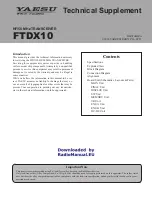
Page 40
O
PERATING
M
ANUAL
A
LTERNATE
VFO O
PERATION
(“F
RONT
& R
EAR
” VFO)
If you press the keypad band key for the same band
that you are already operating on, the display will shift
to a different frequency in the same band (the bottom
of the band by default). Pressing the same band key
again switches you back to the frequency you were on
before. What you have here are two completely inde-
pendent VFO selections for each band, selectable by
each band’s keypad key. You can think of the VFO for
every band having a “front” and “rear” half that can be
swapped for operation by toggling the band key. You
can tune, select a mode and a bandwidth for each of
these two VFO halves in each band, and they will be
remembered until you return to this “sub receiver” se-
lection.
O
PERATION
R
ECEIVING
A practical use of this feature is to configure the
front VFO for phone operation, and the rear half for
CW operation on the same band (see the illustration
above).
For example, if one of your VFOs is set to the SSB
portion of the band (and in an SSB mode), press the
keypad key for that same band, tune to the low end of
the band, and press the [
CW
] mode button. You can
consider this your CW VFO. Now press the band key
again several times, and notice that operation toggles
between the SSB and CW VFO halves. You can also
select different IF bandwidths as well as modes for the
two halves (and even different Clarifier settings). Note
that this feature is not related to the MAIN VFO-A and
SUB VFO-B scheme - dual receive and split operation
will be covered later.
VFO S
ELECTION
& R
ECEIVER
M
UTING
Above the Main and Sub VFO knobs are a pair of
button/LEDs labeled
RX
and
TX
. The illuminated green
“
RX
” LED indicates the VFO(s) controlling the receiver,
while the red “
TX
” LED shows the VFO controlling the
transmit frequency. As we will see later on in dual and
split operation, these buttons can configure semi-du-
plex operation as you choose.
You can mute the Main or Sub VFO at any time by
pressing the
RX
button/LED above the corresponding
VFO knob. The LED blinks while the receiver remains
muted; simply press the button again to unmute.
K
EYPAD
F
REQUENCY
E
NTRY
Frequencies can be entered directly, if desired, as
follows:
Press [
ENT
] at the lower right corner of the keypad
(the leftmost operating frequency digit will blink). Then,
referring to the yellow numbers on the keypad, enter
the digits of the new frequency, from left to right (
1
-
4
-
2
-
5
-
0
-
0
-
0
), followed by [
ENT
] again. As you enter
the numbers, the next digit to be entered will blink on
the display. You can use the
DOWN
(
q
) and
UP
(
p
)
buttons below the keypad to reposition the blinking digit
location as desired (but ignore the direction labels on
these buttons).
Only when you press [
ENT
] the second time will
the operating frequency actually change, so if you de-
cide to remain on the original frequency after starting
to key in a new one, you can cancel any entered digits
by pressing [
SUB
(
CE
)] (“
C
lear
E
ntry,” the yellow label
at the lower left corner of the keypad) instead of [
ENT
].
Note that, to enter frequencies below 10 MHz, you
must
key in the leading zeros.
That’s all there is to tuning Main VFO-A. Sub VFO-
B has a lot more features of its own, which we’ll look at
in detail later. First, however, let’s look at some other
important receiver features.
Toggle VFOs
Summary of Contents for MARK-V FT-100MP
Page 119: ......
















































